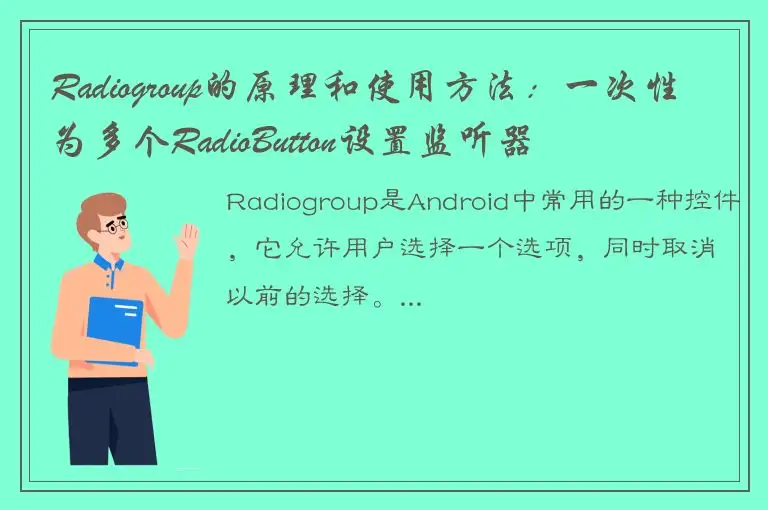Radiogroup是Android中常用的一种控件,它允许用户选择一个选项,同时取消以前的选择。这里的选项通常是由若干个RadioButton组成的,RadioButton是一种单选框。Radiogroup允许我们一次性为多个RadioButton设置监听器,使得选项的处理更加高效和方便。本文将介绍Radiogroup的原理和使用方法,帮助读者更好地理解和使用这个常用的控件。

一、Radiogroup的原理
Radiogroup是继承自LinearLayout的一个类,因此它具有LinearLayout的所有特性,如支持水平排列和垂直排列等。Radiogroup也重写了LinearLayout的几个方法,以实现对RadioButton的处理。例如,它对RadioButton的选择和取消选择的处理,就是通过对两个方法的重写完成的:check和clearCheck。
Radiogroup用一个叫做mCheckedId的变量来保存当前选择的RadioButton的id,以便进行后续操作。当一个RadioButton被点击时,它会通知Radiogroup,并将自己的id赋值给mCheckedId,同时取消之前被选择的RadioButton的选择状态。Radiogroup会在处理完事件后,通过调用当前被选择的RadioButton的onCheckedChanged方法,来执行自己注册的监听器。
二、Radiogroup的使用方法
1.基本使用方法
为了使用Radiogroup,我们需要首先在xml布局文件中定义Radiogroup和若干个RadioButton,如下所示。
```
android:id="@+id/radioGroup" android:layout_width="match_parent" android:layout_height="wrap_content" android:orientation="vertical"> android:id="@+id/radioButton1" android:layout_width="match_parent" android:layout_height="wrap_content" android:text="RadioButton1"/> android:id="@+id/radioButton2" android:layout_width="match_parent" android:layout_height="wrap_content" android:text="RadioButton2"/> android:id="@+id/radioButton3" android:layout_width="match_parent" android:layout_height="wrap_content" android:text="RadioButton3"/> ``` 在Java代码中,我们可以通过findViewById()方法获取Radiogroup和RadioButton,然后注册监听器来处理选项的选择。 ``` RadioGroup radioGroup = findViewById(R.id.radioGroup); // 为Radiogroup注册监听器 radioGroup.setOnCheckedChangeListener(new RadioGroup.OnCheckedChangeListener() { @Override public void onCheckedChanged(RadioGroup group, int checkedId) { RadioButton radioButton = findViewById(checkedId); Toast.makeText(MainActivity.this, radioButton.getText() + " is chosen", Toast.LENGTH_SHORT).show(); } }); ``` 其中,setOnCheckedChangeListener方法需要传入一个OnCheckedChangeListener监听器对象,当选项发生改变时,会回调该对象的onCheckedChanged方法。该方法的第一个参数为触发事件的Radiogroup对象,第二个参数为当前选择的RadioButton的id。 2.代码动态生成 在某些情况下,我们需要在代码中动态生成Radiogroup和RadioButton,例如在RecyclerView中,每个item需要具有选择项。在这种情况下,我们可以使用代码动态生成Radiogroup和RadioButton来实现。 下面是代码动态生成Radiogroup和RadioButton的示例代码,其中的setOnClickListener方法用于注册RadioButton的点击事件。 ``` LinearLayout linearLayout = new LinearLayout(this); linearLayout.setOrientation(LinearLayout.VERTICAL); RadioGroup radioGroup = new RadioGroup(this); // 动态生成RadioButton for (int i = 1; i <= 3; i++) { RadioButton radioButton = new RadioButton(this); radioButton.setId(i); radioButton.setText("RadioButton " + i); radioButton.setOnClickListener(new View.OnClickListener() { @Override public void onClick(View v) { Toast.makeText(MainActivity.this, ((RadioButton) v).getText() + " is chosen", Toast.LENGTH_SHORT).show(); } }); radioGroup.addView(radioButton); } linearLayout.addView(radioGroup); setContentView(linearLayout); ``` 通过这种方法,我们可以实现在代码中动态生成Radiogroup和RadioButton,并为它们注册监听器。 3.样式与主题 Radiogroup和RadioButton的样式和主题可以通过xml文件进行配置,常见的属性有以下几个。 - android:button:指定RadioButton的样式,可以是drawable或color。 - android:checked:指定RadioButton是否选中,默认为false。 - android:textColor:指定RadioButton的文本颜色。 - android:textSize:指定RadioButton的文本大小。 下面是示例代码,其中的android:button使用了drawable资源。 ``` android:id="@+id/radioGroup1" android:layout_width="wrap_content" android:layout_height="wrap_content"> android:id="@+id/radioButton11" android:layout_width="wrap_content" android:layout_height="wrap_content" android:button="@drawable/radio_button_selector" android:checked="true" android:text="Android" android:textColor="@color/colorAccent" android:textSize="20sp"/> android:id="@+id/radioButton12" android:layout_width="wrap_content" android:layout_height="wrap_content" android:button="@drawable/radio_button_selector" android:text="iOS" android:textColor="@android:color/black" android:textSize="20sp"/> ``` 这里的drawable资源为一个选择器,可以指定RadioButton不同状态下的背景色和边框颜色。选择器的xml文件如下: ``` ``` 这里通过选择器来指定RadioButton不同状态下的背景色。在这个例子中,我们定义了二个drawable资源,它们分别对应RadioButton选中和未选中两种状态。注意,这里的drawable资源需要放在res/drawable文件夹下。 三、总结 本文主要介绍了Radiogroup的原理和使用方法。通过Radiogroup,我们可以将一组RadioButton组合在一起,实现选择控制的功能,并一次性为多个RadioButton设置监听器。Radiogroup在Android开发中是一个常用的控件,理解和熟练掌握它的使用方法,对于开发高效、高质量的应用程序非常有帮助。




 QQ客服专员
QQ客服专员 电话客服专员
电话客服专员